Build Your Own Self Watering Containers
This post may contain affiliate links, which means that I may receive a commission if you make a purchase using these links. As an Amazon Associate I earn from qualifying purchases.
Many versions of self watering containers, also known as self watering grow boxes, self watering pots, and self watering planters are sold online, but you can make them yourself for a fraction of the cost out of some easy to find items.

This post on constructing self watering containers out of 18-gallon storage totes was originally written in May 2009 and continues to be popular. I updated the photos, copy, and added additional information.
I still use the original self watering containers each year. I have early blight in my garden soil that often reduces the health and production of my tomato plants. Growing tomatoes in self watering planters allows the plants to grow early blight free for the whole season. Celery also grows very well in self watering pots because they receive a steady moisture level. I have also grown peppers, melons, eggplant, cucumber, and summer squash in self watering containers with great success.
What are Self Watering Containers?
Self watering containers are an enclosed growing system that decreases moisture evaporation and offers a consistent water supply to your plants. It is made up of two chambers, the growing chamber and the water reservoir chamber. The growing chamber contains a wick that descends into the water reservoir that pulls water up into the growing chamber as needed for the plants.
Many versions of self watering containers are sold online. For example, this Self-Watering Planter is almost the same size as an 18 gallon tote. You can make your own self watering container for a fraction of the cost out of some easy to find items.
What are the Benefits of Self Watering Containers?
- Flexible Growing Space: Self watering containers are perfect for container gardens because they can be located anywhere in your yard, on your balcony, or along the edge of your driveway. Place the containers on wheels and you can move them more easily to different locations to take advantage of maximum sun exposure.
- A Consistent Supply of Water: Your plants will have water available to them when they need it and will not suffer from extreme moisture fluctuations that often range between soaking wet and bone dry.
- Provides Moisture to the Roots: When you fill a self watering container, water is stored at the bottom in a separate chamber. Moisture is wicked up into the soil directly to the roots of the plants as needed. In comparison, when you water a traditional container, you add it to the soil surface. If the water doesn’t penetrate deeply enough into the pot, your plants will develop a shallow root system that may stunt growth.
- No Nutrition Loss: Since self watering containers are an enclosed system, nutrients do not get washed away when deep watering like conventional containers.
- Pest and Disease Free: Beginning with fresh growing medium ensures that your plants can become established before pests and disease make their appearance.
- No Weeding: Plastic mulch covers the soil surface preventing weeds seeds from blowing in and sprouting.
How to Build Your Own Self Watering Containers
Materials:
1 18-gallon storage tote with lid (see notes below)
3-4 inch wide container for wicking basket
2 coffee cans to support aeration shelf (see notes below)
24-inch pipe for fill tube, one end slanted
Landscape fabric
1 black plastic garbage bag
Zip ties
1 2 cu ft. bag of organic potting mix (about 52 quarts)
Organic fertilizer
Tools:
Drill with assorted drill bits
Heavy scissors or saw to cut cover
Saw to cut pipe
Marking Pen
Procedure:
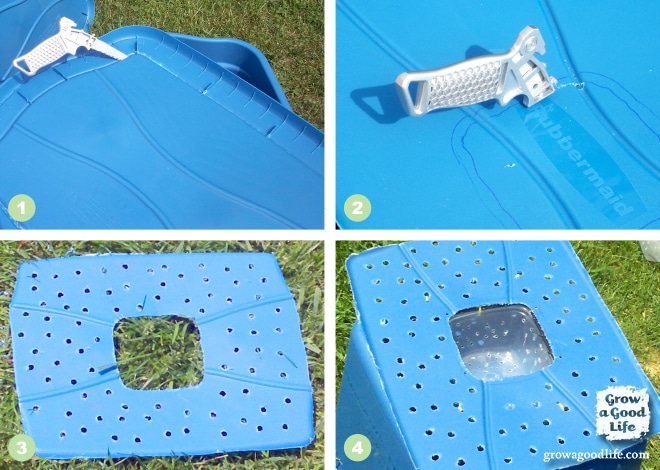
1. Remove the center of the lid. Carefully cut out the center of the lid to be used as the aeration shelf between the soil and the water chamber. Leave about two inches around the lid, so it can be used to hold the plastic mulch to the top of the container later.
2. Cut an opening for the wicking basket. Place your wicking basket at the center of the aeration shelf and trace the edges with your marking pen. Cut the opening slightly smaller (about 1/4-inch) than the outline.
3. Drill holes in the aeration shelf. Drill holes about 1-inch apart for air exchange.
4. Attach Wicking Basket to the aeration shelf. Drill holes a bunch of holes in the wicking basket to allow water to soak through. Drill holes around the edges and attach to the aeration shelf with zip ties.

5. Check the fit. Assemble your shelf supports and aeration shelf inside the tote to check the fit. The shelf should fit snug against the tote with no buckling. Trim the shelf if needed.
6. Drill a 1⁄4-inch overfill hole about 1⁄2-inch below the aeration shelf. Water will come out the overfill hole when the container is full. The hole also allows air circulations between the aeration shelf and the water.
7. Cut an opening for the fill tube. Position fill tube, trace an outline, and cut out the hole for the tube.
8. Add landscape fabric. Trim a piece of landscape fabric to cover the aeration shelf. Try to leave a 2-inch overlap. Cut holes for the fill tube and the wicking chamber. The landscape fabric prevents the soil from dropping down into the water reservoir.
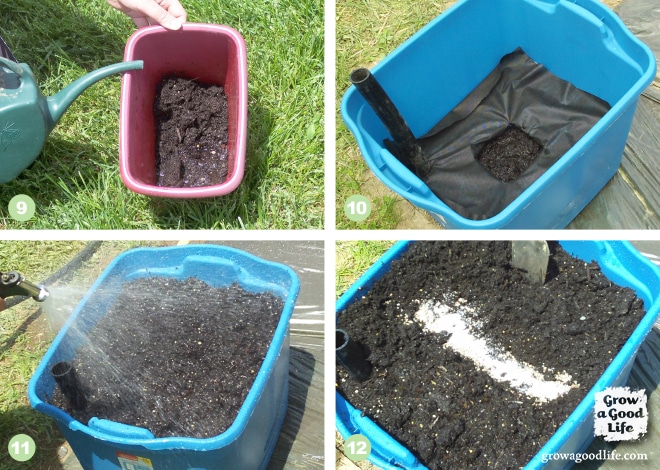
9. Add wet soil to wicking basket. Mix potting soil and water in a container until it is saturated. Pack into the wicking basket.
10. Move container to its final location. Place your self-watering container in its permanent location because it will be too heavy to move after adding the potting mix. Be sure the fill tube is easily reachable to fill with a hose.
11. Fill container with potting mix. Add the rest of the potting mix to the self watering container 3-inches at a time saturating each layer with water until the container is full. This is important, as dry potting mix will not wick water.
12. Add fertilizer. Dig a trench in the soil across the middle of the self watering planter and add 2-cups of fertilizer along the trench. Cover the fertilizer strip with potting mix and water in. Do not mix the fertilizer into the potting mix or spread it around.
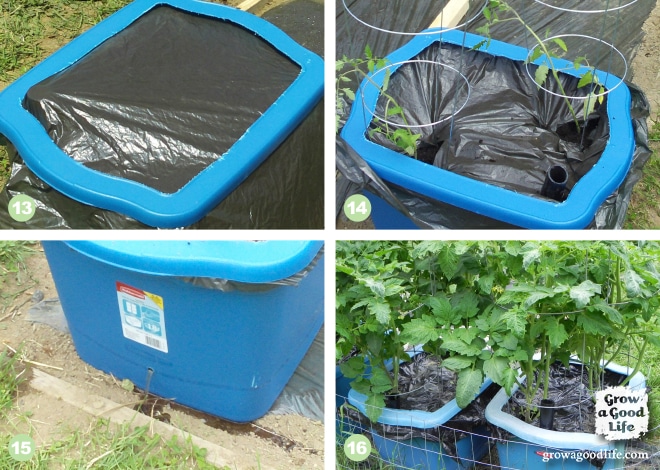
13. Layer plastic mulch. Lay the plastic garbage bag over the filled self watering container and snap on the cover. Cut a hole for the fill tube. The garbage bag will serve as a plastic mulch and help hold moisture in.
14. Plant. Avoiding the fertilizer strip, cut holes in the mulch and add your transplants. I plant two determinant or bush tomato plants in each 18-gallon self watering container, so I cut an X into the solar mulch where the tomatoes will be planted in opposite corners of the self-watering container.
15. Fill water reservoir compartment. Water through the fill tube until water comes out the overfill hole. Add plant supports if necessary. Keep water reservoir full or the wicking action will cease. Top off every day in the heat of summer.
16. Watch your plants grow and enjoy the harvest.
Additional Tips:
- Choose a Good Quality Tote: The Rubbermaid Roughneck and the Sterilite Ultra totes are more flexible and hold up to manipulation without cracking. I found these lovely blue ones on clearance for $5 and these are still being used years later. Simply drain water and store in a shed for winter. You should be able to find these totes at your local big box stores for under $10.
- Aeration Shelf Support: Be sure that whatever you use to hold up the aeration shelf is sturdy enough to support the weight of the potting mix when wet. I use recycled 30 oz. ground coffee containers cut in half to provide a stable shelf.
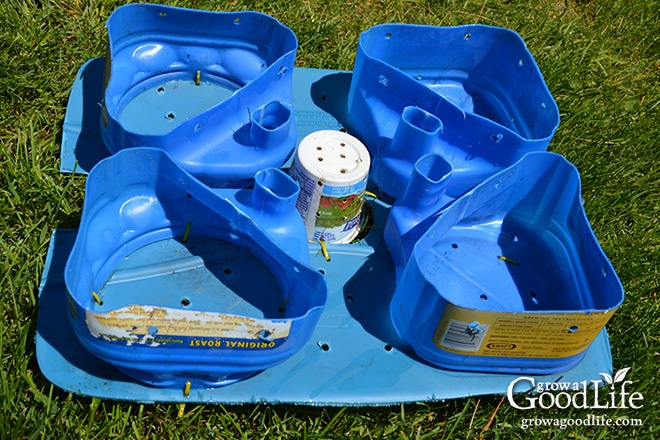
- Wicking Chamber: The wicking chamber container doesn’t need to be very large. I’ve used recycled food storage containers and 8 oz. yogurt containers.
- Potting Mix: Select a good quality, lightweight potting mix suitable for containers or mix your own at the ratio of 45% peat moss, 45% compost, 10% perlite, plus 2 cups of hydrated lime or dolomite. About 2 cubic feet is needed to fill one 18-gallon self watering container.
- Organic Fertilizer: I use Epsoma Plant-tone for growing vegetables and Tomato-Tone for tomatoes.
- Replanting: Reusing self watering planters is easy. Just remove the old plants and old fertilizer strip. Give the soil a deep soaking, replace fertilizer strip, fill reservoir chamber, and replant.
You May Also Like:
- 10 Steps to Starting Seedlings Indoors
- How to Grow Celery from Seed
- How to Harden Off Transplants
- Seasoned Tomato Sauce Recipe for Canning
Good planning is key to a successful vegetable garden
Whether you are new to growing your own food or have been growing a vegetable garden for years, you will benefit from some planning each year. You will find everything you need to organize and plan your vegetable garden in my PDF eBook, Grow a Good Life Guide to Planning Your Vegetable Garden.
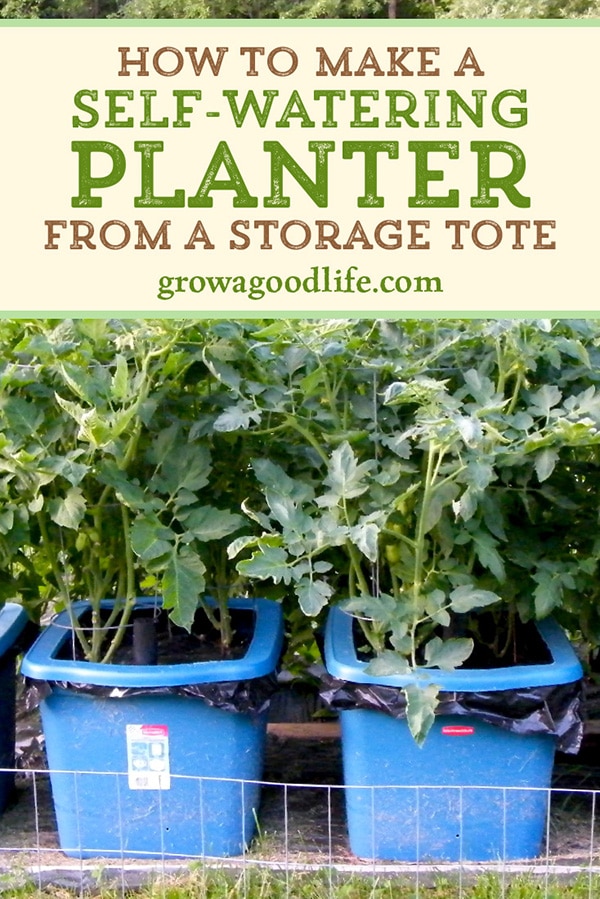


Years ago I built a DIY self-watering container similar to these. Right now, it is growing bearded iris that I rescued from a demolition job, and I can’t transplant them at this time (they have been in it for years and are doing great–they are forming bloom buds right now!). As local produce is hard to find right now, I need to build some new containers. Your instructions are the best I’ve found! Except–how deep is the water reservoir? I can’t remember how deep to make it, and as we don’t buy 30-ounce containers of ground coffee, I’ll need to get creative with something else.
Thanks for your help!
Sandy, About 3-4 inches is a good. I have also used pieces of scrap untreated 2x4s to hold the aeration shelf. They do degrade over time and need to be replaced every 2 years or so, but should work in a pinch.
I just built one of these and am going to find a way to recycle the water that comes out of the over flow hole by putting another planter under it . That way I save water and water another plant also.
Great idea, Tessa!
How long can you go without filling the reservoir? I travel a lot but would still like to have some plants.
Tyler, There are so many things to factor in….It really depends on the plant, the weather, and the wicking action of the soil. During the hottest part of summer, I have fill the containers every other day when growing two tomato plants. Less when the weather is cooler.
I am setting up a selfwatering garden where I cut 55 gal barrels in half the long way, putting 1 inch rock in the bottom. will have water continually running through on side and out the other. I am putting landscape fabric over the rock and then my potting soil on that. I believe the wicking process should work enough that way. Any thoughts.
Mike, The only way to know is to give it a try. Let me know how you make out.
Have you ever used these as containers for trees that will be brought in during the winter? So container trees, lol Thanks!
Jennifer, I have not tried it, but it should work as long as you have something to catch the extra water.
Thank you so much for this tutorial! I’m going to try growing some decorative pumpkins this year and these containers seem perfect for my deck which only gets full sun in a small area. If I am putting one plant in a container, should I do strips of fertilizer along each side or just one off to one side, say opposite the water pipe?
Lizzy, I am glad the tutorial was helpful. If you are using a 15-18 gallon sized tote, you can probably grow two pumpkin plants in each container as long as you have plenty of room for the vines to spread. I would place the fertilizer strip on one side (the water pipe side), and two pumpkin plants on the opposite side. Good luck! If you think of it, drop me a note to let me know how you made out.
I was just looking online for the Rubbermaid totes and it looks like they do not make these anymore. Do you have any other suggestions on what totes to use?
Ah, the Rubbermaid Roughneck storage totes are indeed the best ones to use for this project. A quick search showed me that you might still be able to find them in stores such as Walmart, Home Depot, Target, etc.
Another alternative that looks promising is the newer Sterilite Ultra totes. These seem pretty rugged like the Rubbermaid totes were. They are rather expensive online, but you can find these at Target for around $9.
Rachel, this is an EXCELLENT DIY article. It will be in a special reserved place in my bookmarked gardening tricks.
Can this idea be used for ornamental and flowering plants, like bamboo or whatever? I have several two-part tower planters, made from plastic I am thinking of converting to self-watering, but I’ve never tried with something this large. Any advice appreciated! thx.
Jigs, It should work for any type of plant that needs a consistent amount of moisture.
I’m having trouble getting mine to wick. Followed your building instructions to a T but the water levels in the resorvoirs doesn’t go down and I find I’m having to water. Thinking of somehow inserting lengths of cotton clothesline into reservoirs to help. Any ideas?
Linda, Hmmm, a few troubleshooting questions:
Did you add wet soil to wicking basket?
Did you saturating the potting mix in layers as you added it to the container? This is important, as dry potting mix will not wick water.
Yes, even resorted to rope wicks and have tried resaturating. No luck ?
Linda, I have never used rope wicks, so I cannot advise. Does your wicking chamber reach the water reservoir in the bottom?
Once the soil dries out, it won’t wick water. The only thing I can suggest at this point is to completely soak your self-watering planter. This works for me when I pull out my containers in spring.
Water from the top until the potting soil is saturated, the water is flowing out the drainage hole, and the chamber in the bottom is full. After the soaking, keep the bottom chamber filled with water. If your wicking chamber is in the water, it will wick moisture up into the potting soil.
We have done that twice, even held our fingers over the holes to saturate more. The wicking chambers are well down in the water. Just can’t figure it out. Planted my beans 4 times now but they keep drying out. Quite disappointed so far.